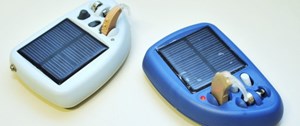Source: Canadian Plastics Industry Association
Solar Ear Relies on Plastics
TORONTO, July 12, 2012 (GLOBE NEWSWIRE) -- The World Health Organization estimates that two-thirds of the approximately 270 million hearing-impaired people around the globe live in developing nations. Yet fewer than 10 million hearing aids are manufactured annually—the costs simply outweigh the demand from the poor in Africa, Latin America, Asia and beyond.
Innovations in plastics are helping alter this imbalance. Plastics are enabling Solar Ear to bring down the cost of hearing aids while increasing their mobility and functionality. The Solar Ear hearing aid looks ordinary enough – just a cashew-shaped piece of plastic to tuck behind the ear – but it costs a fraction of a typical hearing aid and is powered by batteries that are recharged in a plastic solar battery charger.
Solar Ear's innovations in plastics are developing more affordable devices for the hearing impaired around the world.
Q & A's About Solar Ear
Q. What is Solar Ear and how does it work?
A. Solar Ear developed a rechargeable hearing aid battery that costs the same as a regular zinc air battery but lasts two to three years and can fit into any hearing aid. To recharge the hearing aid battery, they invented a plastic solar charger that contains two AA rechargeable batteries. The batteries are charged by the sun and household light or even certain cell phone electrical cords. Then the hearing aid batteries are placed in the charger at night, usually a couple times a week. The solar charger also can be used to recharge AA batteries used in most small home appliances, including TV remote controls, smoke detectors, radios and more.
Q. How is Solar Ear different from other hearing aids?
A: One of the main differences is that it is rechargeable. The other is that it costs a fraction of what a typical hearing aid costs and includes the solar charger and batteries that last for two to three years.
Q. What components of Solar Ear are made from plastic?
A: The key to Solar Ear's success as a company is their solar charger, which is made from a high grade, UV-resistant plastic. They found this material to be of the highest quality to create a durable, lasting product that hearing impaired people around the world could use affordably. Also by using plastics in different colours, they were able to create hearing aids with a little bit of flair – something that greatly increases chances that some people will wear their hearing aids. The design of Solar Ear, which wouldn't have been possible without plastic, has earned Solar Ear a few major international design awards, as well as an exhibition at the Smithsonian Museum and Alexander Graham Bell Museum.
Q: How do plastics make Solar Ear possible?
A: Without the plastics they use for their solar charger they could not have achieved the durability and quality required for their customers. They made their product to be used in the most difficult of surroundings and circumstances, from rural villages in sub-Saharan Africa to the winters of northern Asia. Plastics also help their product be more fashionable, which gives some of their customers an added sense of confidence when wearing hearing aids.
Q: Solar Ear has a unique mentoring and employment program – what is that?
A: Solar Ear is a sustainable social business run by people who are deaf. They hire the deaf that speak in sign language and have highly advanced hand eye coordination. They also train people in developing countries using employees from other developing countries, which is not typical in their field. For example, Solar Ear ran the first technical training course on electronic micro-soldering taught by their deaf experts in Botswana to deaf trainees in Brazil.
Q: What is the vision for the future for Solar Ear and people with hearing impairment?
A: Solar Ear has been able to show companies that have visited their factories the quality of work, and now these companies are starting to hire people who are deaf. They realize that these are people who are deaf and not deaf people. Secondly, they have been so successful that organizations are asking them to open in other countries, given they have proven technology and a proven business model, plus they transfer all technology for free. They have plans to open ten more affordable hearing aid programs over the next five years, increasing the supply of hearing aids by a million more a year, hiring more than 1,500 young adults who are deaf. And plastics will help make that possible.
Today's intelligent plastics are vital to the modern world. These materials enhance our lifestyles, our economy and the environment. For more information visit www.intelligentplastics.ca
The Canadian Plastics Industry Association is the national voice of Canada's plastics industry, representing the interests of processors, material suppliers, equipment manufacturers and brand owners across the country.
For More Information:
Darlene Gray, Marketing Communications Specialist
Canadian Plastics Industry Association
t. 905.678.7748 ext. 239
A photo accompanying this release is available at: http://www.globenewswire.com/newsroom/prs/?pkgid=13636
